|
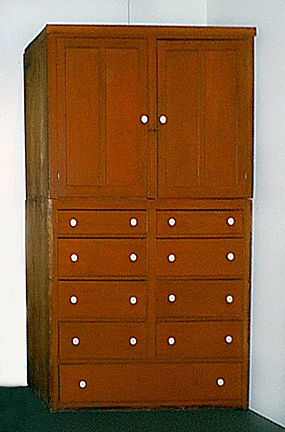 Everyone
is familiar with Shaker chairs, but most people don’t know that the Shakers
invented all sorts of storage units, including built-ins which are common in
today’s homes. Since they made these storage or case units for themselves,
they aren’t as prevalent in the antique marketplace. Everyone
is familiar with Shaker chairs, but most people don’t know that the Shakers
invented all sorts of storage units, including built-ins which are common in
today’s homes. Since they made these storage or case units for themselves,
they aren’t as prevalent in the antique marketplace.
How It All Began
The Shakers began as an offshoot of the Quakers in1747. The name came from
the paroxysms which seized worshipers when their religious fervor reached a
critical level. It was their unstinting belief in the second coming of
Christ “without ostentation, parade or any vain show, and naturally leads
plainness in all things” that set them apart from the Society of Friends.
According to Shaker law, order is the creation of beauty, and beauty rests
on utility. All beauty that hasn’t a foundation in use, soon grows
distasteful, and needs continual replacement with something new.
Such values undeniably affected the work of the Shaker cabinetmaker, guiding
his search for chaste design and unity of form. The moral obligation to do
work which was worthy of a sacred cause, kindled the desire to raise one of
the essentials of fine craftsmanship, utility, to such a level of perfection
that Shaker products assume a formalized character not possessed by ordinary
utilitarian objects.
Shaker Furniture Design
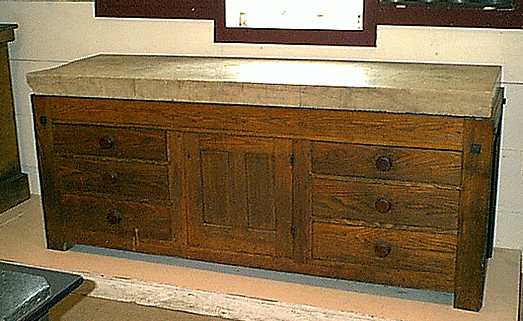 The
Shakers made all the furniture used in their communal dormitories. They
designed their case or storage furniture-built-ins, chests, cupboards, work
benches, cabinets, bureaus, blanket boxes, tailoring benches, etc—largely
for their own use, so case pieces didn’t find their way into the world in
the same way as did their chairs. The
Shakers made all the furniture used in their communal dormitories. They
designed their case or storage furniture-built-ins, chests, cupboards, work
benches, cabinets, bureaus, blanket boxes, tailoring benches, etc—largely
for their own use, so case pieces didn’t find their way into the world in
the same way as did their chairs.
Shaker joiners employed a variety of woods, choosing the best local ones.
The Northern communities, such as Canterbury, in New Hampshire, New Lebanon,
in New York, and Hancock, in Massachusetts, used mostly pine, with maple a
close second. In later days, the Canterbury, New Hampshire, joiners used
butternut. Many cabinetmakers favored cherry, either alone or combined with
maple, for tables.
At Groveland, New York, and in Kentucky and parts of Ohio, Shaker joiners
used walnut extensively because of the large stands of these trees in these
areas. Kentucky joiners commonly used cherry, both because of its easy
availability and Southern tradition. The Shakers didn’t use exotic woods,
like rosewood and mahogany, used in Colonial times. Neither did they use
inlay, except for keyhole escutcheons, or veneer, insisting on the honesty
and beauty of solid woods.
Shaker Woodworking Techniques
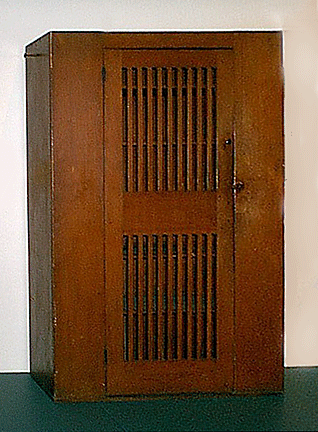 Joiners
first chose the best and most knot-free, carefully air-seasoned stock for
cabinetry, then expertly crafted it. They never used blind joints, but
extended the mortises through to the other side, exposing the end. Not only
was this easier to make but stronger. Joiners
first chose the best and most knot-free, carefully air-seasoned stock for
cabinetry, then expertly crafted it. They never used blind joints, but
extended the mortises through to the other side, exposing the end. Not only
was this easier to make but stronger.
Shaker craftsmen pegged cabinet door joints, not one above another, but
staggered, so the holes wouldn’t follow the grain. Thus pegged, it was
difficult for a door to sag. The enclosed panels were usually flat on the
outside, chamfered on the inside.
Early and smaller pieces had dovetailing, but larger furniture, like tall
chests of drawers, generally had sides nailed together with square
cut-nails. Although cabinetmakers used staple hinges and occasionally
leather strap hinges on early blanket boxes and chests, they favored
wrought-iron butt hinges. Northern Shakers especially liked using offset
butterfly-hinges with a long tongue on the lid on blanket boxes. This was
apparently not a Shaker design, as such hinges can be found on non-Shaker
pieces as well.
If the Shakers were so pious, why did they use commercial locks on their
cabinet doors and drawers? No one knows. In earlier days, they attached a
rectangular or diamond-shaped escutcheon of bone or ivory to the exterior of
the door or drawer. Later locks came with a metal inset rim-escutcheon.
Finishes varied with period and locality. Northern Shakers either lightly
oiled, or stained their furniture blue, red or yellow. They also used dark
moss green as a paint and not as a stain. But they used several shades of
red and yellow as both paint and stain. Craftsmen generally stained, then
varnished hardwoods. Western Shakers used stains less than their northern
brethren.
Shaker Case Pieces
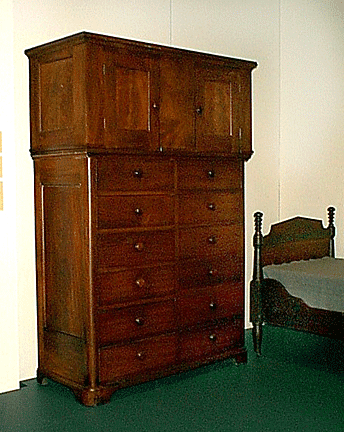 The
forms of case pieces followed no defined categories because of their wide
variety of uses. For example, wood boxes varied markedly in size and design.
They were short and shallow, generally, if they were for kindling, and
larger, deeper and longer for stovewood. Sometimes craftsmen added a
kindling-wood shelf to the top of a large stove-wood box. Other wood boxes
came equipped with lids. Some had removable towel-racks or storage
compartments above. Very often, joiners inserted delicately turned small
knobs into the sides on which to hang a dustpan and brush or other
implements. The
forms of case pieces followed no defined categories because of their wide
variety of uses. For example, wood boxes varied markedly in size and design.
They were short and shallow, generally, if they were for kindling, and
larger, deeper and longer for stovewood. Sometimes craftsmen added a
kindling-wood shelf to the top of a large stove-wood box. Other wood boxes
came equipped with lids. Some had removable towel-racks or storage
compartments above. Very often, joiners inserted delicately turned small
knobs into the sides on which to hang a dustpan and brush or other
implements.
Shakers didn’t like corner cupboards, even though outsiders, known as the
World’s People, did. It seems the Shakers had an aversion to cattycorner
furniture.
The wardrobe, an uncommon Shaker form, seemed to be restricted to Kentucky
Shaker communities. The Northern Shakers preferred either to fold and put
away clothing in large drawers--often built in great banks built into attic
storage rooms in dwelling houses--or hung on open hangers in under-eaves
attic spaces.
Shaker tailors needed furniture with long, broad tops on which to spread out
cloth for cloaks, suits and other clothing. Cabinetmakers made these flat
work surfaces in different sizes in pine or maple stained red or clear
varnished, with banks of drawers and/or cabinets beneath.
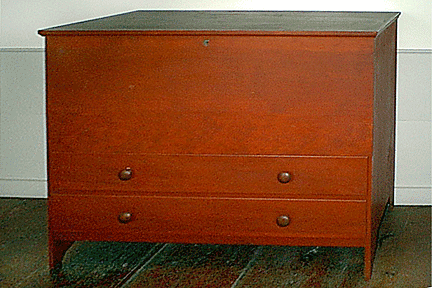 Another
popular case piece was the blanket chest. Purists differentiate between a
blanket chest, which had a storage compartment at the top and one or two
drawers below, and the blanket box with no drawers and built low. The
latter, far more often than the former, had a built-in till compartment with
a peg-hinged lid, found at one or both ends of the box. But the blanket
chest, occasionally found with a hanging drawer attached to the bottom of
the frame, very seldom had a built-in till. The drawers found below the
storage area naturally cut into the depth of the storage compartment.
Shakers sometimes painted these chests dark moss green or red. But often
they varnished them or stained them chrome yellow. Red paint was much more
common on the blanket boxes. Both chests and boxes were much more common in
the Northern communities than in the Western. Another
popular case piece was the blanket chest. Purists differentiate between a
blanket chest, which had a storage compartment at the top and one or two
drawers below, and the blanket box with no drawers and built low. The
latter, far more often than the former, had a built-in till compartment with
a peg-hinged lid, found at one or both ends of the box. But the blanket
chest, occasionally found with a hanging drawer attached to the bottom of
the frame, very seldom had a built-in till. The drawers found below the
storage area naturally cut into the depth of the storage compartment.
Shakers sometimes painted these chests dark moss green or red. But often
they varnished them or stained them chrome yellow. Red paint was much more
common on the blanket boxes. Both chests and boxes were much more common in
the Northern communities than in the Western.
Blanket chests frequently had plank legs, the inner sides of which had an
angle of about 15 inches from the vertical, running up to a plain horizontal
skirting. Comparable Kentucky pieces generally had lathe-turned stubby legs
a few inches in height.
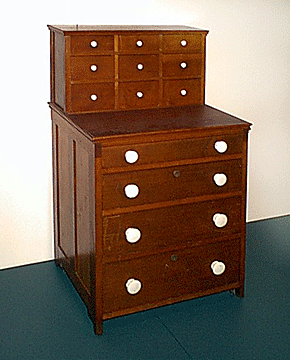 A
highly specialized form of chest was the big carpenter's chest or box,
fitted out to hold various types of tools used by the cabinetmaker, who
dovetailed the corners for greater strength, and quite often used cast-iron
or hand-forged drop handles for ease in moving. A
highly specialized form of chest was the big carpenter's chest or box,
fitted out to hold various types of tools used by the cabinetmaker, who
dovetailed the corners for greater strength, and quite often used cast-iron
or hand-forged drop handles for ease in moving.
A furniture design found almost exclusively in the West, especially in
Kentucky, was the sugar chest, a nearly square box with a hinged lid, set on
legs of medium height. Those found in Kentucky are usually of walnut or
cherry.
Cherry or walnut dressers, or "bureaus," aren’t common in the North, but are
in Ohio and Kentucky. A comparable piece of furniture found in the North is
generally much taller, rising to a height of five to nine feet. (Shakers
used small movable stepladders to access to the upper sections.) These tall
chests with storage cupboards above the ranks of drawers are known as
cupboards-over-drawers. They’re one of the most popular Shaker case pieces.
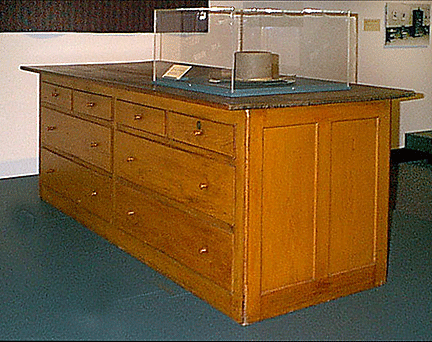 Shaker
seamstresses found the sewing desk or table essential. It’s probably the
most unique of all Shaker furniture. If it had a pull-out slide to increase
the working surface, it was generally called a "desk" and without a slide, a
"table." The Northern forms differed markedly from the Western. In the
North, they usually had banks of drawers in graduated sizes--top, bottom and
side--while the Western version stood on slender legs, sometimes of the
sawbuck type. It had one drawer or none, and a low spindled gallery. These
tables were much smaller, elicate, and elegant than their Northern
relatives. In the Northern communities, two Sisters often shared a sewing
desk. The first used the left-hand upper bank of drawers and those in the
front of the base, while the second used the right-hand upper bank and the
end drawers of the base. These desks stood on short, simply tuned legs. Shaker
seamstresses found the sewing desk or table essential. It’s probably the
most unique of all Shaker furniture. If it had a pull-out slide to increase
the working surface, it was generally called a "desk" and without a slide, a
"table." The Northern forms differed markedly from the Western. In the
North, they usually had banks of drawers in graduated sizes--top, bottom and
side--while the Western version stood on slender legs, sometimes of the
sawbuck type. It had one drawer or none, and a low spindled gallery. These
tables were much smaller, elicate, and elegant than their Northern
relatives. In the Northern communities, two Sisters often shared a sewing
desk. The first used the left-hand upper bank of drawers and those in the
front of the base, while the second used the right-hand upper bank and the
end drawers of the base. These desks stood on short, simply tuned legs.
The Shakers, like other 19th-century housekeepers, had tin cupboards for
holding kitchen and dining room tinware or toleware. They constructed these
of pine, severely plain, usually tall and narrow and with two doors
concealing several shelves. They used other types of cupboards of varying
forms in their infirmaries, printing offices, tailor's shops.
The craftsmen of this busy formative period rejected such the forms of the
highboy and lowboy, the canopy-bed, various types of tables not only because
they were more difficult to make, but because the Shakers, under the
influence of Ann Lee’s teaching, desired no commerce with pretense or
worldliness.
The Essence of Shaker Furniture Design
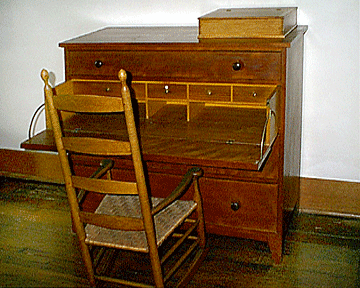 Since
a useful piece of furniture must first be sound and strong, the Shakers
started with this premise and then went on to consider all other facets of
its function. This involved studying how the furniture would be used, the
people who would use it, the most appropriate materials for its
construction, the proper dimensioning of its parts, and its absolute
adaptability to the environment of its use. Since
a useful piece of furniture must first be sound and strong, the Shakers
started with this premise and then went on to consider all other facets of
its function. This involved studying how the furniture would be used, the
people who would use it, the most appropriate materials for its
construction, the proper dimensioning of its parts, and its absolute
adaptability to the environment of its use.
Despite their versatility, when Shaker craftsmen created what they regarded
as a perfectly useful design, they often retained that design for an
indefinite period thereafter.
Shaker craftsmen made their furniture perfectly plain. They whittled their
work down to perfect proportions and introduced functional features seldom
found in the colonial furniture of early America. Instead, they retained and
refined the solid-wood patterns of previous centuries adding their own
improvements to create a style uniquely "Shaker."
<
Back to
Antiques Articles
Go to the next antiques article >
|
